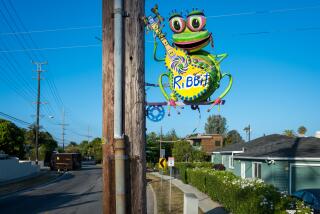Towers of Power
- Share via
Marvin Rand’s detailed photos of the Watts Towers brought back vivid childhood memories (“View From the Top,” by Mary Melton, Nov. 9). In 1949, we lived on 107th Street, a few blocks from Simon Rodia’s work-in-progress. The then-quiet, manicured middle-class neighborhood was a postcard for postwar suburbia.
Sometimes my parents would take me to watch Rodia work. I remember him hunched over, digging through trash, looking for discarded objects to embed in his amazing skeletal edifice. To me, a 5-year-old, he was an intriguing but frightening figure from a fairy tale--dressed in rags, covered in cement dust and talking in a strange accent. I can still picture him breaking bottles, dishes and ceramics and--rapidly, intuitively--placing them in the wet cement like pieces in a puzzle that only he could visualize.
Rodia’s strange, bold construction was unsettling. At the time, I got the distinct impression that we had a genuine madman in our neighborhood, and no one quite knew what to make of it or what should be done. But we proudly watched in wonder.
Robin Simmons
Desert Hot Springs
*
As the author, with Arloa Paquin Goldstone, of the book “The Los Angeles Watts Towers,” in which Marvin Rand’s photographs are featured, I have found dozens of Watts Towers-related errors printed by the news media, including the statement in your article that there are 70,000 seashells in the Towers. There are actually only 8,000.
In 1986, every seashell and ornament on the 17 sculptures was cleaned and chemically treated. Also, the book was published by the Getty Conservation Institute and the J. Paul Getty Museum.
Bud Goldstone
Los Angeles
*
I was quite pleased to see a photo essay on one of my favorite spots in Los Angeles. How unfortunate that the main photograph on Page 19 is reversed.
Richard J. Tafilaw
Burbank
More to Read
Sign up for our Book Club newsletter
Get the latest news, events and more from the Los Angeles Times Book Club, and help us get L.A. reading and talking.
You may occasionally receive promotional content from the Los Angeles Times.










